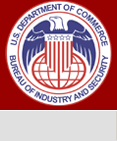Where Industry and Security Intersect
What's New | Sitemap | Search


The MTAC meeting was held on 1 February 2007 in the Department of Commerce (DoC) building, room 6059. The meeting was called to order at 10:30 AM by the Chairman in conjunction with Dr. Kimberly Orr, Designated Federal Official. The meeting consisted of an open session non-MTAC/public visitors in attendance and a closed session with only MTAC members and DoC personnel present. The meeting agenda consisted of six (6) topics in the open session: Introductions and opening remarks, status and discussions on the China Rule, delineation of the new chemical and biological regulations, defining a request for input on synthetic genomics, update on the actions of the Composite Working Group, and report from the last Chemical Weapons Convention.
Attendance:
Material TAC Members:
Dr. James Estep, Chairman
Mr. Robert Anstead
Dr. Scott Hubinger – DoC/BIS/CBC
Mr. Anthony Lubiniecki
Mr. Tom May
Mr. Eric McClafferty (new member)
Mr. Andrew Skibo
Dr. Gillian Woollett
Dr. Kimberly Orr, Designated Federal Official – DoC/BIS
Mr. Beth Scott - Director, DoC/BIS/CBC
Ms. Yvette Springer - Govt. Liaison – DoC/BIS
Department of Commerce Attendees:
Mr. Matt Borman, Deputy Assistant Secretary, DOC
Ed Freedman, DoC/BIS
Gerry Horner – DoC/BIS/OTE
Jennifer Watts – Trades and Industry Analyst, DoC/BIS
Public/Visitors:
Steve Goldman – DoC Director of Office of Nonproliferation and Treaty Compliance, retiring 3/1/2007
Margo Hammon - Dir, Export Control, Verzion
Kenneth W. Hutton – Logistic Mngr, Hyperion Catalysis Int’l, Inc
Susan Renton, Senior Counsel, Tyco Valese Controls
Kandi Shejanah – International Trade Specialist, Steptoe & Johnson LLP
The meeting was opened at 10:30 AM with introductions including the introduction of Beth Scott who is the new Director, Chemical and Biological Controls (BIS/DoC). Farewell wishes were given to Mr. Steve Goldman who is retiring from Federal service after 32 years. We all wish Steve the best in his new career path.
There was an introduction of a new member to the TAC, Mr. Eric McClafferty.
Following introductions, Mr. Matt Borman, Deputy Assistant Secretary, led discussions on the China rule (People’s Republic of China (PRC) revisions and clarifications of export under15 CFR Parts 740, 742, 744, 748). The proposed changes were designed to increase commerce by facilitating trade with legitimate end users in the PRC, while not supporting current/ongoing military modernization efforts. The rule permits the designation of validated end users, which, after such designation, will reduce the requirements for specific export licensing to those organizations. This will facilitate the export process. Discussion on the scope/aspects of the rule can be found in the September 2006 MTAC minutes. There was additional discussion on taking this approach with other countries; an example is India which may also become a validated end-user country.
Follow on discussion by Mr. Borman centered on the need for review of ECCNs in the chemical and biological arena. He solicited input from the TAC members on the need for systematic review and updating the language of the EAR in this important arena. There was extensive discussion on the need to review current language to ensure that language captures the current technology for control without unduly burdening commerce. One example of where there could be a need for updating is that the language for 2B350, chemical processing equipment, is 20-30 years old. Is the language capturing the current technology without causing unnecessary restriction? The discussion continued as members touched on several current technologies in the biomedical area (biosensors, DNA sequencing, etc) that may or may not be covered since this field is changing so rapidly. The computer technology
The outcome of this discussion was the decision by the TAC to undertake a review of the ECCNs, overall, and determine if any should be/needed to be revised; specifically, by looking at them from the perspective of out-of-date technology restrictions and adequacy of proliferation control without being excessively restrictive. The approach would be for the DoC to send to the TAC members a specific listing of the ECCNs covering this arena, the members would review them from a standpoint of currency, and come prepared to discuss the ones that they felt needed to be updated or rewritten. Any that were felt by the TAC to need reworking would then be undertaken systematically. The list of ECCNs was to be sent out prior to the next meeting giving members time to prepare for follow on discussions.
There was discussion on synthetic genomics and if this technology was covered by current language, but with little comment by the TAC. There was follow-on/associated discussions on a recent publication by the National Science Advisory Board for Biosecurity titled, “Addressing Biosecurity Concerns Related to the Synthesis of Select Agents,” dated December 2006. Dr. Orr obtained a copy of this publication from the NSABB’s website. There was a short discussion on associated select agent control by other regulations (7 CFR Part 331, 9 CFR Part 121, 42 CFR Part 73). Discussion on this document was tabled until the next meeting to give people time to review as the needed.
The open meeting ended with the closed meeting continuing after non-TAC members departed the room.